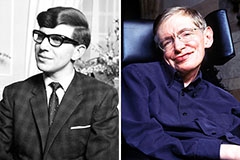The James Webb Space Telescope boasts the capability to peer into the immense depths of space, allowing us to witness the subtlest glimmers of light from the initial galaxies. These extraterrestrial structures appeared after the Big Bang, unveiling the enigmatic conditions that existed in the space's infancy. JWST's infrared vision cuts through the interstellar veil, providing us with a window into these primitive worlds.
By studying the properties of these primitive galaxies, astronomers hope to unravel the secrets of galaxy evolution and the foundation of the universe as we know it.
Examining the Birth of the Universe
Cosmic Genesis represents a profound quest to understand the universe's birth. From the infinitesimally small singularity to the vast expanse of stars and galaxies, scientists embark on a journey through time, constructing together the cosmic puzzle. Early forces molded the structure of reality, giving rise to the elements and the laws that govern our existence. Through cosmological observations and mathematical models, we strive to decode the mysteries of this grand cosmic tapestry.
- Astronomical evidence from distant galaxies and the cosmic microwave background radiation illuminates light on the universe's primordial stages.
- Conceptual frameworks, such as the Big Bang theory, suggest a blueprint for understanding the universe's development.
- Unending research and technological breakthroughs extend the boundaries of our knowledge of cosmic genesis.
Through the Cosmic Dawn: JWST's Glimpse into Early Galaxy Formation
The James Webb Space Telescope views into the mysterious depths of the early universe, revealing a awe-inspiring panorama of nascent galaxies. These distant celestial bodies, formed in the ancient times, provide invaluable information into the progression of galaxies over billions of years. The JWST's sophisticated instruments observe light from these primitive galaxies, enabling astronomers to map their development and {unravel{the complex processes that shaped the structure of the cosmos.
- Scientists are currently analyzing the JWST's observations, searching for indicators about the properties of the original galaxies and the circumstances that prevailed in the early universe.
- Those groundbreaking discoveries are transforming our perception of the universe's origins and providing a peek into a intriguing epoch in cosmic history.
Infrared Echoes: Unlocking Secrets of the Universe's Infancy
The cosmic universe is shrouded in mystery, its faint whispers echoing through space and time. But now, astronomers are using a powerful tool to pierce this veil: infrared echoes. These waves, stretching back to the universe's initial stages, offer a unique glimpse into its infancy. By analyzing these echoes, scientists can interpret the secrets of the first stars and galaxies that lit up the cosmos billions of years ago. This fascinating research is shedding new light on the universe's genesis, helping us understand how everything we see today came to be.
- One potential area of study involves the search for evidence of exotic particles in these echoes. By observing anomalies, astronomers hope to identify the presence and influence of this elusive phenomenon.
- Another important aspect is the study of the early galaxies. Infrared echoes can reveal their properties, shedding light on how they developed over time. This powerful data allows astronomers to formulate a more complete picture of the universe's growth.
JWST's Deep Dive: Illuminating the Origins of Galactic Structures
The James Webb Space Telescope (JWST) is unraveling the mysteries of the universe at an unprecedented level. Its powerful instruments are peering deep into space, Epoch of Reionization exposing the earliest galaxies and structures that formed after the Big Bang. By analyzing the light from these distant objects, scientists hope to obtain invaluable insights into the development of galactic shapes. JWST's observations are forming a new understanding of how galaxies came to be, shedding light on the fundamental processes that shaped the cosmos we study today.
- The telescope's infrared vision allows it to bypass vast clouds of gas and dust, revealing hidden regions where stars are born.
- Additionally, JWST can capture the faintest signals from the earliest galaxies, providing a glimpse into the universe's infancy.
With its cutting-edge technology and unparalleled capabilities, JWST is altering our view of the universe. Its discoveries are continuously pushing the boundaries of human knowledge, bringing us closer to unraveling the grand cosmic narrative.
Witnessing the Universe's Dawn: The James Webb Telescope and Early Galaxies
observing into the tremendous depths of space, the advanced James Webb Telescope is exposing secrets about the cosmic dawn. Documented in stunning resolution, early galaxies appear as brilliant beacons from a ancient era. These fragile structures, coalescing shortly after the Big Bang, provide crucial clues about the development of the cosmos. The telescope's infrared vision penetrates the cosmic veil, allowing us to witness a period in time when the universe was fledgling. Researchers are thrilled by these groundbreaking discoveries, as they illuminate new light on the genesis of galaxies and the universe itself.
 Luke Perry Then & Now!
Luke Perry Then & Now! Tiffany Trump Then & Now!
Tiffany Trump Then & Now! Bo Derek Then & Now!
Bo Derek Then & Now! Stephen Hawking Then & Now!
Stephen Hawking Then & Now! Rossy de Palma Then & Now!
Rossy de Palma Then & Now!